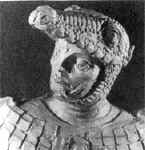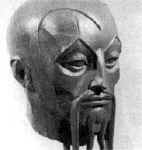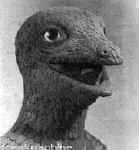|
Maximum Respect (and a kingdom) to
Earthling  Adam Gross Adam Gross , who supplied and emailed the many
megs of scans that make up this article. Cheers
Adam. Images and words (c) Mediascene
Prevue # 42 , who supplied and emailed the many
megs of scans that make up this article. Cheers
Adam. Images and words (c) Mediascene
Prevue # 42
For a printable version of this article, click here.
NOTE:
Mentor Huebner sadly passed away on March 19th 2001. His widow expressed
appreciation of this site, and we thank her for it and wish her well.

A
FASCINATING BEHIND-THE-SCENES LOOK AT THE ART OF STORYTELLING AND CINEMATIC
TECHNIQUE CREATED BY ONE OF HOLLYWOOD’S MOST RESPECTED PRODUCTION
ILLUSTRATORS:
MENTOR HUEBNER
ALL SCULPTURES AND ILLUSTRATIONS ARE FROM THE NEW DINO
DE LAURENTIIS PRODUCTION “FLASH
GORDON”
Flash Gordon first rocketed to Mongo in 1934, to find a fantasy world
filled with alien monsters and beautiful maidens, satanic villainy and ray-gun
justice.
 When Star Wars and the ensuing
armada of science-fiction films blasted off in 1977, they too were aiming for
the wondrous adventure planet of Mongo. Some flew closer than others, but their
high-tech spaceships never managed to travel in the same idealized stratosphere
that nurtured the fair-haired Flash and his stalwart compatriots. When Star Wars and the ensuing
armada of science-fiction films blasted off in 1977, they too were aiming for
the wondrous adventure planet of Mongo. Some flew closer than others, but their
high-tech spaceships never managed to travel in the same idealized stratosphere
that nurtured the fair-haired Flash and his stalwart compatriots.
Flash Gordon has become a
legend throughout the world, particularly in Europe, where aficionados have
embraced the extraordinary flair and imagination generated over 45 years ago by
the strip’s creator, Alex Raymond. For years, followers of the classic comic
strip have hoped their champion would assume his stellar position in the
celluloid pantheon of larger-than-life heroes.
This Christmas, the definitive Flash Gordon
movie will be launched, fuelled by $27 million, and guided by an international
flight crew. Produced by Dino DeLaurentiis, and directed by Michael Hodges, the
film has been scrupulously planned to retain the adventurous spirit and
striking visual style which made the newspaper strip so popular.
The casting of Flash was of paramount importance to the overall battle
plan. The coveted title role went to newcomer Sam Jones, best known to date as
Bo Derek’s bridegroom in 10. Flash’s lovely companion, Dale Arden, is
portrayed by Canadian-born Melody Anderson, who interprets her role as, ”very
spunky, very New York City, but with a nice, vulnerable side.’ The scientific
prophet, Doctor Hans Zarkov, is brought to life by renowned actor Chaim Topol
(Fiddler on the Roof). If villains always get the best lines, Max Von Sydow
will have them as Emperor Ming the Merciless. There’s even a suitably wicked
and emaciated acting assignment for Rocky Horror hunchback Richard
O’Brien, as clown prince Fico.
Of equal importance to the cast is the
unique ”look” of the Flash Gordon universe – a mise en
scene of
deco-type architecture, rococo ornamentation and colourful paramilitary
costumes. Add exotic jungle and mid-air fortresses, high-finned rocketships and
futuristic multi-turreted leviathans, and the result becomes a heavy challenge
to those who must envision these elements. That challenge was accepted by
Italian production designer Danilo Donati, famed for his stage and film work
with Federico Fellini, Franco Zeffirelli, and many others.
By the end of Flash Gordon’s
shooting, there were enough production drawings, character sketches, costume
designs, set blueprints, and storyboards to wallpaper a palace on Mongo. A
catalogue tallying the artists’ work from December 1978 to February 1980 (and
annotated with offbeat comments from the contributors), indicated a total of 642
pieces.
The most prolific artist for the film,
however, was production illustrator Mentor Huebner, interviewed by PREVUE
for his selective, behind- the-scenes viewpoint of Flash Gordon. His work
on the storyboards pulled together every aspect of the project – from drama to
design.
 Huebner was actually the third artist to
create storyboards for Flash Gordon. Three years ago, when Nicholas Roeg
was the assigned director, he had his own artist conjure up an interpretive,
metaphysical Mongo. His concept of the film was devoid of comic-strip design and
shoot-’em-up melodramatics. Instead, it envisioned Flash as a
metaphysical messiah. He abandoned, for example, Raymond’s classic slab-sided
towers; they were replaced by a startling crystalline version of the city Mingo.
Unfortunately for Roeg. DeLaurentiis wanted the Flash Gordon of the comics. Huebner was actually the third artist to
create storyboards for Flash Gordon. Three years ago, when Nicholas Roeg
was the assigned director, he had his own artist conjure up an interpretive,
metaphysical Mongo. His concept of the film was devoid of comic-strip design and
shoot-’em-up melodramatics. Instead, it envisioned Flash as a
metaphysical messiah. He abandoned, for example, Raymond’s classic slab-sided
towers; they were replaced by a startling crystalline version of the city Mingo.
Unfortunately for Roeg. DeLaurentiis wanted the Flash Gordon of the comics.
When Mike Hodges took over the directing
chores, he set out to create his own shorthand storyboards. Cutting images from
science-fiction comics, art books and fantasy magazines, the director assembled
over 20 collages to create an unusual, yet comprehensive, film version.
Mentor Huebner became Flash’s
permanent production illustrator soon after shaking the South Seas sand of
DeLaurentiis’ Hurricane from his hair. Travelling the globe in the
course of his profession, Huebner works wherever film producers need him, taking
advantage of the opportunity to soak up historic atmosphere on long, weekend
walks. Spending several months in London for Flash, Huebner was the only
English-speaking member of the Italian art department. When interviewed, he was
working in a North Hollywood office, planning the up-coming DeLaurentiis version
of E. L. Doctorow’s Ragtime.
Personable, candid and willing to share the
memories of more than a hundred feature films since he entered the business in
1952, Huebner was, relaxed in a room surrounded by his charcoal and crayon
drawings for Meteor, King Kong and other big-budget blockbusters. He
revealed that he had originally visualized the staging of classic scenes such as
the chariot race from Ben-Hur and the biplane chase through the
cornfields in North by Northwest. He was also the designer of George
Pal’s memorable Time Machine – ”It wasn’t the best idea I presented to
him, but George was quite taken with that whirling disk I put on the back.”
Over the last thirty years, Huebner has
served as production designer, illustrator or art director on such movies as
The Longest Day, Fiddler on the Roof, The Amityville Horror, 10, Lord of the
Rings, Forbidden Planet, Westworld, The Great Race, Damnation Alley and the
upcoming Under the Rainbow and S.O.B. He has also exercised his
penchant for historical settings by contributing to the atmospheric TV
productions of The Man in the Iron Mask, The Count of Monte Cristo and
Les Miserables.
An artist who genuinely loves to draw,
Huebner creates countless storyboards every year. He taught life-drawing classes
at a California university for 20 years, and has had numerous gallery showings
of his paintings. More than a simple draftsman. however, Mentor finds that the
skills required to be a first-rate production illustrator include being a
functional designer with a thoroughly detailed knowledge of set construction,
special effects, screen composition, lighting, storytelling, costume designing,
editing, cameras, lenses, and space-time coordination.
”The production illustrator,” he
explains, ”is the guy who gets the script, reads, ’500 Indians sprang out of
the bushes,’ and has to solve the problems of putting those Indians
realistically on the screen. Where do they come from? How did they get there?
Are they on horses? Where are the horses? Where have they been hiding? These are
the questions the writer didn’t resolve when he typed the scene.
”Production illustrators are real
money-savers for producers. Some younger directors and executives don’t
understand how to use our skills effectively, and try to ramrod through
situations without storyboards. But, on a really elaborate film, with multiple
camera setups, stars and extras, 500 Indians and their horses could cost up to
$100,000 a day. Every minute is precious. There’s no time for improvising or
debating with the cameraman about the field of vision. Three bad days on a big
film could equal my income for nearly three years. It also makes financial sense
to lay everything out, shooting as tightly and economically as possible, instead
of guessing and leaving a half-million bucks on the editing room floor.
 ”Some directors, like Blake Edwards, use
boards and collaborate freely, usually for the chases and tricky technical
problems. Two- people-in-a-room scenes rely mostly upon the actors, but fifty
people in a room have to be choreographed for the camera so that the audience
won’t see the dolly tracks, crane shadows, or reflector lighting panels. Then,
there are the directors who are resentful of anyone planning their shots; it
infringes on their creativity. ”Some directors, like Blake Edwards, use
boards and collaborate freely, usually for the chases and tricky technical
problems. Two- people-in-a-room scenes rely mostly upon the actors, but fifty
people in a room have to be choreographed for the camera so that the audience
won’t see the dolly tracks, crane shadows, or reflector lighting panels. Then,
there are the directors who are resentful of anyone planning their shots; it
infringes on their creativity.
“Flash Gordon was a great film experience. Working with Mike Hodges was a real
pleasure, because he’s the most sensitive person I’ve dealt with in a long
time, a marvellous raconteur – I think he’s really a frustrated actor at
heart. He lent a sympathetic ear when I’d say, ’Mike, this scene just
won’t play.’ We’d sit down and work out concepts together, rewriting the
script at my drawing board.
”I’ve done about 2000 storyboards for
Flash over the past two-and-a-half years, along with a number of 20 x 40”
detailed set studies for the construction department. The script was rewritten
four or five times along the way. Much of the drawing was very detailed because
Dino wanted the technicians to see everybody and everything in every panel. When
you have over $25 million invested you want to know what’s happening to all of it. We were on six stages at Shepperton, all the Star
Wars facilities at EMI, and in a six-million-cubic-foot complex at
Brooklands. I had to do a lot of drawing to fill all that space.”
In addition to positioning all the people
on the ground, Huebner also had to solve a number of aerial difficulties when it
came to the scenes involving King Vultan and the Hawkmen of Mongo. He not only
designed the wing-like jet packs which replaced the ponderous previous versions,
but also had to determine the cameraman’s angles so that the Hawkmen, kept
fourteen feet apart by their wings, would appear to be only three feet apart –
conversational distance – when delivering dialog.
 In a spectacular flying sequence, Huebner
devised a way to simulate an entire squadron of flying men with eight actors,
thirty miniatures and triple optical printing – completed in post-production
by the special effects crew under Frank (Superman) Van der Veer’s
supervision. The man who actually constructed the Hawkmen’s wings, Glenn
Robinson, performed a similar task 40 years ago for The Wizard of Oz’s
flying monkeys. In a spectacular flying sequence, Huebner
devised a way to simulate an entire squadron of flying men with eight actors,
thirty miniatures and triple optical printing – completed in post-production
by the special effects crew under Frank (Superman) Van der Veer’s
supervision. The man who actually constructed the Hawkmen’s wings, Glenn
Robinson, performed a similar task 40 years ago for The Wizard of Oz’s
flying monkeys.
The essential
plot for the DeLaurentiis version of Flash Gordon is rather like the
original comic strip – Flash, Dale and Dr. Zarkov fly to Mongo to avert an
interplanetary collision. Princess Aura, King Barin and other familiar
characters turn up during the struggle to overcome the tyranny of Ming the
Merciless. The Earth settings have been updated by screenwriter Lorenzo
Semple Jr., who reportedly received $225,000 for the finished script.
”But,” interjects
Huebner, ”even the most talented writers forget simple time and space problems
when they are concentrating on the dramatic instead of the visual end of the
story. At one point, we used a 175-foot-long set with Ming’s throne
constructed at one end: Flash was to crash his rocket at the opposite end, go
through a corridor, and up the stairs to the throne. I got the screenplay and
found the landing scene described as ’Flash Gordon staggers out of his crashed
rocket and says to Ming – “Oh, yeah?” The two actors are 175 feet apart! I blocked out a
series of shots with various angles and quick takes to signify a short passage
of time, just to bring Ming and Flash together. It was nothing sensational, just
necessary for the story flow.”
Though his storyboards resemble comic book
panels, and function in much the same way, Huebner’s attention to detail and
practicality goes far beyond the four-color realm, even on such a
comics-inspired project as Flash Gordon ’I remember the original Alex Raymond
strips quite well, and we had the reprinted books in my office, Mike’s and
Dino’s. We used what we could, but some designs were too impractical to build,
so we adapted the material, and retained the artistic flavor.
”I like working with Dino, even though he
can be very demanding, because he treats me with consideration. He’ll call me
and say, ’Hey, Mentor. I want you to go to England tomorrow morning, work
maybe five, six weeks.’ Then, he will see to it I’m put up in a nice hotel
and be well
taken care of. He’s not like a lot of producers who won’t even let you go to
the library for research – they figure you have been hired to draw, so they
damn near chain you to the board, and won’t spring for bus fare to Burbank.”
Few of his drawings are ever returned to
Huebner, not even those done for films which were never made. ”They’re
stolen,” he explains. ”People take them for souvenirs. I try to get as many
as I can myself, because they’re valuable to me as a guide to what I’ve
already done. The rest wind up on producers’ walls, studio files and film
archives.
“As an artist, I appreciate audience
reaction to my work, even if nobody knows that the scenes they’re watching
developed partially through my efforts. But the projects that are most
frustrating will always be the ones that never quite got off the ground, like
the handful I designed with George Pal, including Iceberg, which he was
working on when he died.
”I like production
illustration because it presents me with challenging situations which require my
particular ability to both draw and work out the mechanics of getting a good shot or pacing a
difficult scene. Often, just the quality of my work is satisfying, particularly
if I am able to create a cohesive overall atmosphere for a film.
Sometimes, I’ll see the movie in a theater just to find out if it works
with the audience.
“In an illustrative sense,
I am directing movies on paper. I’ve
even toyed with the idea of becoming a Director, but I’m just not sure I could
handle the actors well. I’m too used to nailing them down on my drawing hoard
– I don’t know if I’d like to start watching them move all by themselves.”
The storyboards reproduced in
this special PREVUE portfolio are from Huebner’s files and present
prime examples of his best work. Note
the skilled familiarity with which he draws the human figure reflecting his many
years of study. Many production
artists have an awkward, architectural approach towards drawing people, as opposed to Mentor’s easy
facility, solid
mastery of forms and appealing warmth and humanity.
Note Huebner’s skill with cinematic
imagery and the sequential staging of action, supplemented by directional arrows to indicate
camera motion and character movement. By constantly altering sizes of elements,
points of view and angles of vision, he introduces stimulating visual variations
which engage viewer interest. By focusing on even the unimportant details and
rendering every figure in the crowd scenes, Mentor conveys an accurate
impression of exactly what figures, textures and emotional impressions the camera
should see.
“This sequence is from one of the earlier
drafts of the screenplay,” Huebner explains, “and has been altered somewhat
for the final version. The soldier who throws himself on the sword was changed
into a Lionman and put into an arena with a monster, I believe, to tie into the
original Flash Gordon material.
”This was the way I originally staged the
initial face-off between Flash and Ming, just after their landing on Mongo,
juggling over a half-dozen major characters, and trying to show what types of
personalities they have through the pictures alone. As you can see, Flash
doesn’t fare to well in this sequence.
”But then, this is Flash Gordon we’re dealing with, and the
movie has only just begun.”
 Steve Daniels Steve Daniels
CLICK
HERE FOR THE STORYBOARD ART
If you like / hate this site, please TELL ME!
|







